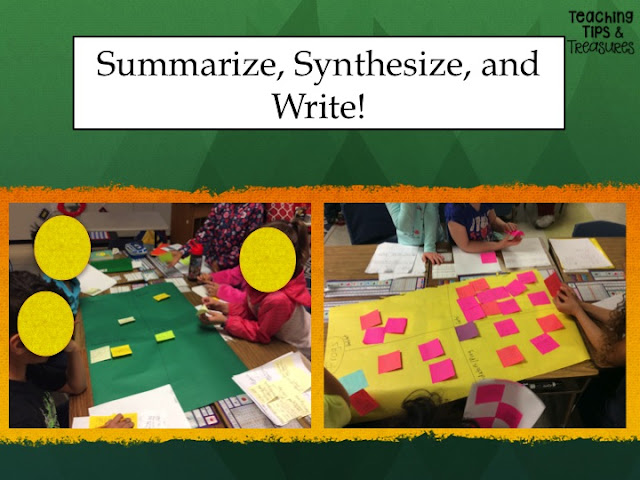This post is the 3rd in a series of posts on how to use inquiry based group research projects. The previous post covered asking and answering questions. In this post, we will:
3. Summarize, synthesize, and write.
The next step in the process requires students to work together. At this point in the project, students should have the answers to most of their questions on their post-its. They may even have additional information they think is important to include. Although students have been working independently to read and gather information, it is now time for each group to work collaboratively. Prior to releasing them to their groups, you will want to model the expectations.
For this part, you will need your post-it notes on the topic you are modeling. As my students are researching animals, I chose to model using turtles as my focus. I also had a large poster sized paper on display. I gathered the students together as a class and showed how I could group my notes into categories. I did a "think aloud" as I read some of the post-its and noticed ways they were alike. I discovered that I could group my post-its into the following categories: Appearance, Habitat, Predators and Prey, and Interesting Facts.
I took a large poster sized paper and divided it into these categories. Next, I read each post-it and decided where it fit on the poster. After modeling my thinking, I sent the students back into their animal groups to do the same. Again, everyone was accountable because each person had several post-it notes to categorize.
The great thing about this part of the activity is that the students really have to talk and work together to decide where certain notes will be placed. Also, if there are 2 notes that say the same thing, they have to decide which one to eliminate. Students will develop their negotiation and compromising skills during this step. Depending on how frequently your students have worked together in the past, you may need to do a mini-lesson on how to respectfully and politely discuss ideas. This part of the project can be difficult for some students. You will want to teach those students how to compromise.
One interesting thing that happened with one of my groups was that 2 students found conflicting information in different texts. One source stated a certain speed that a wolf could run while another book gave a different number. This led to a great discussion on why they thought that happened. They also talked about how to decide which fact to include. As the facilitator of this lesson, I just prompted by asking questions. I left the decision making up to the group.
Once all of the notes are sorted, it's time to assign individual roles to the group project. Each person in the group will become accountable for one category. In some cases you may have 2-3 students assigned to one category. In a six person group, I assigned 1 person to Appearance, 1 to Habitat, 2 to Predators and Prey, and 2 to Facts. Again, although this is a group project, there is individual accountability.
Remember that all of the group's notes have been sorted and categorized on a large poster. Each group's poster will need to be cut apart so that individuals can work on their section of the project.
The person (or people) will be responsible for taking all of the notes for their category and synthesizing the information. They will need to write a paragraph or page (depending on the amount of information gathered) that will be shared with all of the members of their group. The need for neat writing and use of conventions becomes critical here. Students have to write legibly and coherently because their team is depending on them! (more on that in the next post)
This is another step that needs to be explicitly modeled. Using my own information about turtles, I showed the students how I thought of a question to guide me for each category. For example, when looking at the "Appearance" section, I needed to answer, "What does a turtle look like?" Keeping the question in mind will help the students stay focused on writing about their topic which is the next step.
This is where another shift in the project will occur. You will want to meet with all of the students who are responsible for the same category as one group. For example, there was one person from the shark groups, one from the wolf group, etc. who was assigned to work on "Appearance." By working with small groups you can provide support and modeling when needed. I usually met with these small groups during our Daily 5 time. Think about what mini-lessons these groups will need. How will you model synthesizing the information? You may decide to model these lessons to the whole class as one group, or you may differentiate the lessons based on what each small group needs.
So, let's look at what has happened so far. We started with a broad topic: animals. Students were then assigned one animal to research. This created 4 smaller groups. Each person in the group had to think of questions and gather information related to their animal. These questions and answers were pulled together on a large poster sized chart and grouped into the following categories: Appearance, Habitat, Predators and Prey, and Interesting Facts. Students were then assigned one category from the poster. Next students used all of the notes gathered by their group to work on one section of the project. The next step will bring the individuals back to the group.
In the next post, I will explain how to bring the pieces together and polish and publish the project.
Thanks for stopping by!









